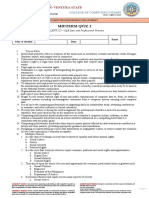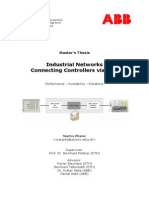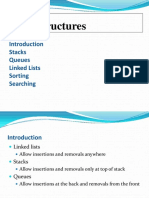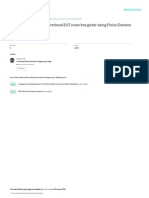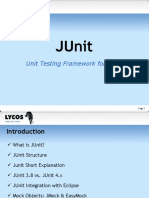Research Paper On Arduino and Its Application
Uploaded by
KunalResearch Paper On Arduino and Its Application
Uploaded by
KunalTechnology based laboratory to improve science learning
Avinash Kumar Shudhanshu, Raj Kumar, Sadashiv Raj Bharadwaj, Gaurav Singh, Amit Garg*
*corresponding author
Acharya Narendra Dev College, University of Delhi, Govindpuri, Kalkaji,
New Delhi-110019, India,
E-mail: amit_andc@yahoo.co.in
AbstractTill date, manual routine tools and techniques are used
to perform various experimental procedures in most of the
science laboratories in our country. The manual tools are
cumbersome whereas the automated ones are costly. It does not
enthuse young researchers towards the science laboratories.
There is a need to develop applications which can be easily
integrated, tailored in school and undergraduate level
laboratories and are economical at the same time. Equipments
with advanced technologies are available but they are
uneconomical and have complicated working principle with a
black box approach. The present work describes development of
portable tools and applications which are user-friendly and can
be interfaced with different mobile platforms like android. This is
being implemented using open-source physical computing
platform based on a simple microcontroller board and a
development environment for writing software for the board. An
arduino microcontroller board with SDK is being used for
interfacing different sensors for measuring required parameters
during various experiments. These sensors include but not
limited to light, sound, temperature, salinity etc. Robust
application soft wares are being developed using eclipse IDE in
Java and other programming languages. These tools will inspire
young researchers towards science and facilitate development of
advance low cost equipments making life easier for Indian
society.
boost students to design new experiments and work in the
depth of concept.
Though we have automated a range of experiments, we
discuss two of them in this paper. They are:
Calculating time period of a simple pendulum
Measuring intensity of light
\
II.
EXPERIMENTAL SETUP
The generic form of basic experimental setup for any of
the experiments listed above is shown in Fig.1
Experiments
Sensors
Keywords- Science laboratory, sensors, Android, Arduino, Eclipse,
Open-Source, Microcontroller.
I.
INTRODUCTION
Over the last few years there has been a substantial increase
in use of sensors across the world in all domains which has
eased our life as well as research/education in various fields.
However, being expensive there use is only limited to
commercial and higher level laboratories. This paper reports
a low cost method of acquiring data from different sensors
and extending this system to perform different experiments at
various levels. Low cost, tailoring as per the need and easy
deployment make this system suitable for schools and
undergraduate laboratory.This provides a learning
environment using sensors and advanced tools for data
acquisition and analysis offers many opportunities to students
to perform experiments in science and technology in real time
to investigate physical phenomena. An automated science
laboratory will enhance interest as well as productivity of
students in research by reducing time of collecting and
analyzing data. New technology with increased accuracy will
Arduino
Microcontroller Board
Android Phone/PC/LCD
Fig.1 Generic experimental setup
As shown in Fig. 1, the experiment is set up in its
conventional form and the data from it is captured using
some type of sensor like voltage sensor, rotary sensor, light
sensor etc.. These sensors are interfaced through to the
microcontroller board like arduino and then to the PC,
Android Device, LCD or any other display device. The
various types of microcontroller board can be used; here
we have used Arduino Mega ADK as it also provides
interface to most common mobile platform i.e. Android.
Some of the features of the Arduino Mega ADK used in
these experiments are discussed below:
1.Arduino: It is a single-board microcontroller, intended
to make the application of interactive objects or
environments more accessible. The hardware consists of
an open-source hardware board designed around an 8bit Atmel AVR microcontroller, or a 32-bit Atmel ARM.
Pre-programmed into the on-board microcontroller chip is
a boot loader that allows uploading programs into the
microcontroller memory without needing a chip (device)
programmer. An Arduino Mega ADK Board is shown in
Fig. 2.
Fig. 2 An Arduino Mega ADK Microcontroller Board
The Arduino integrated development environment (IDE) is
a cross-platform application written in Java, and is derived
from the IDE for the Processing programming
language and the Wiring projects. It is designed to
introduce programming to artists and other newcomers
unfamiliar with software development. It includes a code
editor with features such as syntax highlighting, brace
matching, and automatic indentation, and is also capable
of compiling and uploading programs to the board with a
single click. A program or code written for Arduino is
called a "sketch. Arduino programs are written in C or C+
+. The Arduino IDE comes with a software library called
"Wiring" from the original Wiring project, which makes
many common input/output operations much easier. Users
only need define two functions to make a runnable cyclic
executive program:
Some key features of Arduino microcontroller board are
listed below:
i.
Microcontroller
ATmega2560
ii.
Operating Voltage
5V
iii.
Input Voltage
7-12V
(recommended)
iv.
Input Voltage
6-20V
(limits)
54 (of which 15
v.
Digital I/O Pins
provide PWM
output)
vi.
vii.
viii.
Analog Input Pins
DC Current per I/O
Pin
DC Current for 3.3V
Pin
ix.
Flash Memory
x.
xi.
xii.
SRAM
EEPROM
Clock Speed
16
40 mA
50 mA
256 KB of
which 8 KB
used by
bootloader
8 KB
4 KB
16 MHz
List of some sensors interfaced with Arduino:
i.
Light sensor
ii.
Sound level meter
iii.
Drop counter
iv.
Motion Sensor
v.
O2 gas sensor
vi.
pH sensor
vii.
CO2 gas sensor and many others
2. Eclipse: In computer programming, it is an integrated
development environment (IDE). It
contains a
base workspace and an extensible plug-insystem for
customizing the environment. Written mostly in Java,
Eclipse can be used to develop applications. By means of
various plug-ins, Eclipse may also be used to develop
applications in other programming languages: Ada, C, C+
+, COBOL, Fortran, Haskell,JavaScript, Lasso, Perl, PHP,
Python, R, Ruby (including Ruby
on
Rails framework), Scala, Clojure, Groovy, Scheme,
and Erlang. It can also be used to develop packages for
the software Mathematica. Development environments
include the Eclipse Java development tools (JDT) for Java
and Scala, Eclipse CDT for C/C++ and Eclipse PDT for
PHP, among others.Eclipse uses plug-ins to provide all the
functionality within and on top of the runtime system. Its
runtime system is based on Equinox, an implementation
of the OSGi core framework specification. Fig.3 shows a
screen shot of Eclipse IDE
The Eclipse IDE for Java Developers contains what you
need to build Java applications. Considered by many to be
the best Java development tool available, the Eclipse IDE
for Java Developers provides superior Java editing with
validation, incremental compilation and cross-referencing.
Eclipse supports a rich selection of extensions, adding
support
for Python via pydev, Android development
via Googles ADT, JavaFX support via e(fx)clipse, and
many others at the Eclipse Marketplace.
Fig. 3 screenshot of an Eclipse IDE
ii.Measuring intensity of light
However, there are a lot of measuring instruments which
measures intensity of light conveniently. But they have a
very complicated operational mechanism which is not
easy to understand and makes it costly as well. We used a
simple light sensor using Si photodetector to sense
intensity of light. We mounted the light sensor such that it
is exposed toward the source of light whose intensity is to
be measured. Its output is then connected to analog input
port of the arduino board. The arduino board has been
calibrated as per the specifications of the light sensor to
display intensity of light in lux (luminous intensity or
luminous flux). This is shown in Fig.5
III. RESULT AND DESCUSSION
We discuss the details of the two experiments which have
been listed in section I.
i.
Light source
light sensor
Arduino
Display
Fig. 5 Schematic of measuring intensity of light
Bob Pendulum
III.
CONCLUSION
The present development shows how an open source
microcontroller board can be deployed for acquiring data
from sensors and further displaying these data on LCDs
and other most common mobile platform i.e. Android. It
helped undergraduate students integrate technology into a
science laboratory, use same set of hardware components
in different experiments, tailor the set up as per their
learning need. At the same time, it helped in examining
closely the underlying concept of experiment, minimising
the time of experiment and reducing the error. Students
have been able to complete error free experiment and go
beyond the realm of the syllabus to develop innovative
ideas.
Laser Diode
IV.
ACKNOWLEDGEMENT
Authors duly acknowledge University of Delhi for
providing financial assistance under Innovative Projects
from Colleges scheme for the project Development of
Low cost computer controlled science laboratory using
sensors and open source hardware and software tools
against sanction no. ANDC-202.
Calculating time period of a simple pendulum: For a
complete understanding of calculation of time period
through the electronic hardware in the laboratory, the
experimental setup is as shown in figure 4. Laser light is
made incident on the pendulum in the plane perpendicular
to the oscillation of pendulum and a light sensor is
mounted behind it to sense the intensity of light. Each
time the bob of the pendulum oscillates it obstructs the
laser beam and ano light condition is sensed by the light
sensor. The microcontroller has been programmed to
calculate the time difference and display the time period
on LCD.
light sensor
Arduin
i.
Displ
Fig. 4.Schematic showing an automated experiment to calculate time
period of simple pendulum
ii.
iii.
iv.
V.
REFRENCES
https://www.eclipse.org/
http://www.arduino.cc/
http://www.android.com/
http://www.vernier.com/location/?redirect=
%2Fproducts%2Fsensors%2F
You might also like
- CH 10 Mobile Technology and Its ApplicationsNo ratings yetCH 10 Mobile Technology and Its Applications30 pages
- Gas Leakage Sms Message Alert GAL SMART Detection SystemNo ratings yetGas Leakage Sms Message Alert GAL SMART Detection System28 pages
- Human-Computer Interaction - Assignment 6No ratings yetHuman-Computer Interaction - Assignment 63 pages
- Case Study On Amazon Simpledb For A Particular Real-World ApplicationNo ratings yetCase Study On Amazon Simpledb For A Particular Real-World Application7 pages
- Unit I Introduction To Computers (INTRO To COMPUTING LEC)100% (1)Unit I Introduction To Computers (INTRO To COMPUTING LEC)23 pages
- A Brief Computer History: First Generation (Vacuum Tube Based)No ratings yetA Brief Computer History: First Generation (Vacuum Tube Based)3 pages
- Outline Paper - RVM With Shredder InnovationNo ratings yetOutline Paper - RVM With Shredder Innovation5 pages
- Interface PIR Sensor To Arduino - Motion Sensor - DetectorNo ratings yetInterface PIR Sensor To Arduino - Motion Sensor - Detector7 pages
- Design and Implementation of Motion Detection Alarm and Security SystemNo ratings yetDesign and Implementation of Motion Detection Alarm and Security System16 pages
- Valenzuela City Polytechnic College: The Problem and Its Background and Review of Related Literature and StudiesNo ratings yetValenzuela City Polytechnic College: The Problem and Its Background and Review of Related Literature and Studies6 pages
- Philippine Identification System Through The Lens of Technology Acceptance ModelNo ratings yetPhilippine Identification System Through The Lens of Technology Acceptance Model11 pages
- Android Based Student Notice AnnouncementNo ratings yetAndroid Based Student Notice Announcement18 pages
- SAFIRE - Smart Arduino Based Fire Incident Response and EvaluationNo ratings yetSAFIRE - Smart Arduino Based Fire Incident Response and Evaluation23 pages
- Design and Fabrication of Mini DC VacuumNo ratings yetDesign and Fabrication of Mini DC Vacuum7 pages
- Home Security Using Fingerprint Scanner and Keypad Lock With Sms NotificationNo ratings yetHome Security Using Fingerprint Scanner and Keypad Lock With Sms Notification24 pages
- .Emergency Notification Services Application Design For Mobile DevicesNo ratings yet.Emergency Notification Services Application Design For Mobile Devices2 pages
- President Ramon Magsaysay State University: Course Code: Ce 112 COURSE Title: Civil Engineering OrientationNo ratings yetPresident Ramon Magsaysay State University: Course Code: Ce 112 COURSE Title: Civil Engineering Orientation18 pages
- Chapter Five: Design Rules and Implementation SupportNo ratings yetChapter Five: Design Rules and Implementation Support45 pages
- Door Lock Security System Based On Face Image As A Key Using Image Processing100% (1)Door Lock Security System Based On Face Image As A Key Using Image Processing95 pages
- Mechatronics Presentation On Electrical Actuation & Mechanical Switches0% (1)Mechatronics Presentation On Electrical Actuation & Mechanical Switches29 pages
- Solar Powered Smart Ultrasonic Insect Repellent With DTMF and Manual Control For AgricultureNo ratings yetSolar Powered Smart Ultrasonic Insect Repellent With DTMF and Manual Control For Agriculture4 pages
- Effects of Sounds Building Science and Services100% (3)Effects of Sounds Building Science and Services19 pages
- Android Mobile Application On Poultry MarketingNo ratings yetAndroid Mobile Application On Poultry Marketing6 pages
- Computer Generations: 1940 - 1956: First Generation - Vacuum TubesNo ratings yetComputer Generations: 1940 - 1956: First Generation - Vacuum Tubes3 pages
- Mobile Based Campus Guide System For HuNo ratings yetMobile Based Campus Guide System For Hu76 pages
- SMART Clock and Watch: An Arduino-Based Security System100% (1)SMART Clock and Watch: An Arduino-Based Security System87 pages
- Republic of The Philippines West Prime Horizon Institute, Inc. Course Syllabus in Language and Education ResearchNo ratings yetRepublic of The Philippines West Prime Horizon Institute, Inc. Course Syllabus in Language and Education Research12 pages
- Thesis Mcrl01e Menoza A Mendoza J Perante Mallari 3No ratings yetThesis Mcrl01e Menoza A Mendoza J Perante Mallari 357 pages
- Scribd Download - Com Computerized Student Information System0% (1)Scribd Download - Com Computerized Student Information System72 pages
- University of Houston: Computer-Aided Design Mid-Term Project 1 Spring 2017No ratings yetUniversity of Houston: Computer-Aided Design Mid-Term Project 1 Spring 201725 pages
- Speech Emotion Recognition: Two Decades in A Nutshell, Benchmarks, and Ongoing TrendsNo ratings yetSpeech Emotion Recognition: Two Decades in A Nutshell, Benchmarks, and Ongoing Trends9 pages
- Digital Nurture 3.0: Deep Skilling Handbook - Salesforce DeveloperNo ratings yetDigital Nurture 3.0: Deep Skilling Handbook - Salesforce Developer7 pages
- Industrial Networks Connecting Controllers Via OPC: Master's ThesisNo ratings yetIndustrial Networks Connecting Controllers Via OPC: Master's Thesis93 pages
- Groovy 9 - Capturing Rawrequest & Response: or orNo ratings yetGroovy 9 - Capturing Rawrequest & Response: or or4 pages
- University of Waterloo Midterm Examination Solutions: Marking Scheme (For Examiner Use Only)No ratings yetUniversity of Waterloo Midterm Examination Solutions: Marking Scheme (For Examiner Use Only)14 pages
- The Magic Cafe Forums - Lebanon Circle Compendium of Bizarre MagicNo ratings yetThe Magic Cafe Forums - Lebanon Circle Compendium of Bizarre Magic9 pages
- Design Optimization of Overhead EOT Crane Box Girder Using Finite Element MethodNo ratings yetDesign Optimization of Overhead EOT Crane Box Girder Using Finite Element Method6 pages
- Lesson Plan: Getting Started With PythonNo ratings yetLesson Plan: Getting Started With Python23 pages
- Control Hardware and IO Modules Firmware Upgrade Guide EPDOC-X150-en-501ANo ratings yetControl Hardware and IO Modules Firmware Upgrade Guide EPDOC-X150-en-501A45 pages
- HTML Cheat Sheet - A Simple Guide To HTMLNo ratings yetHTML Cheat Sheet - A Simple Guide To HTML6 pages
- Awake Security vs. Extrahop Reveal (X) : Network Traffic Analysis: Feature Comparison GuideNo ratings yetAwake Security vs. Extrahop Reveal (X) : Network Traffic Analysis: Feature Comparison Guide10 pages
- Artificial Intelligence and Structural Health Monitoring of Bridges A Review of The State-of-the-ArtNo ratings yetArtificial Intelligence and Structural Health Monitoring of Bridges A Review of The State-of-the-Art21 pages
- Cambridge IGCSE: Computer Science 0478/22No ratings yetCambridge IGCSE: Computer Science 0478/2216 pages













































